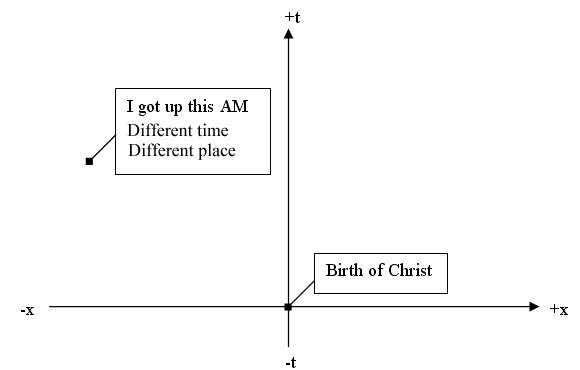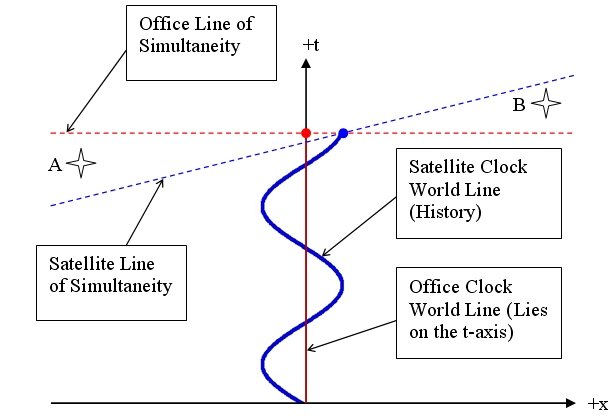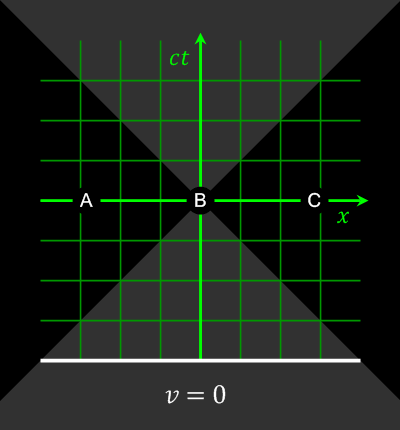|
All together now - wait, is that even possible...
Not that long ago, in the history of thought, time was a simple enough notion. It just ticked along in the background, providing temporal separation among events, giving our lives a certain irreversible order. In the last one-hundred years that idea of time has pretty much slipped from our grasp to be replaced with a flexible slippery thing that acts in ways quite contrary to our intuition. Some aspects of this new time still trouble me, for instance the simultaneity situation. I'm sure this in my problem, having not thought deeply enough about this. Perhaps by getting these issues down in print I can get more organized in my thinking.
I think I must begin with the principle of relativity that Albert Einstein is most famous for. We don't have time to retrace the steps in the development of that theory. Please read my relativity notes to get the important points. The effects of relativity seem strange to us because for speeds small compared to the speed of light and times long compared to the time for light to go a centimeter or so, which all the speeds and times we experience directly are, these effects can be ignored. For those slow speeds and long times, Newton's laws of motion and gravitation produce all the precision we need.
Perhaps I should back up a bit and approach the strange effects of relativity a bit more carefully. First of all, read the spacetime notes to get some necessary background. One of the tools used in analyzing the effects of relativity is the spacetime diagram. It is not convenient to plot more than two dimensions on a flat screen so in the spacetime diagram normally it is the x and t dimensions of spacetime shown, with x horizontal and t vertical. Spacetime diagrams represent a snapshot at a particular instant. Below is a basic spacetime diagram showing two events in spacetime, one marking a commonly used zero on the time axis, the other perhaps less widely known.
 In addition to isolated events we can plot the all the events encountered by an object on its journey through spacetime, including the sort of null event "object found here". The resulting path is called the object's worldline. Shown below are the worldlines of three objects. The red line represents an object at rest in the reference frame of this diagram. The blue object is moving left at a constant speed from the positive x direction. The green object is moving right at a constant speed from the negative x direction.
The above diagram represents a snapshot at a particular age of the universe. The Big Bang marks the beginning of time as we know it and since it happened everywhere at once we should find the same age for the universe everywhere. This is confirmed by the cosmic microwave background radiation.
A more complex spacetime diagram would represent a satellite in orbit about Earth. We will have reason to see this diagram later, on another page. The satellite would be moving in three spatial dimensions as well as drifting up the t-axis at the speed of light. Our diagram only shows the x component of the satellite's spatial position. This diagram specifically applies to two clocks, one in the satellite and one in my office. The motion of the office clock is so slight compared to that of the satellite clock that the office clock worldline lies pretty much on the t-axis. The two stars, A and B are two events, represented as points in spacetime. The dashed lines represent lines connecting simultaneous events, called lines of simultaneity, for each of the two objects represented. Notice that for the office clock event A is in the past and event B is in the future. For the satellite clock event A is in the future and event B is in the past. This weird state of affairs needs some further explanation.
 Most folks have a common understanding of what is meant when we say two events are simultaneous - they happen at the same time. On a spacetime diagram, for an observer at rest in the reference frame of the diagram "at the same time" means with the same time coordinate. Connecting all the events that are simultaneous for that observer would be a horizontal line that we call a line of simultaneity. This is the situation for the office clock. So far so good. The difficulty comes in trying to establish a line of simultaneity for the satellite clock, which is definitely not at rest in the reference frame of the diagram.
It turns out that the geometry of spacetime, because of that pesky -1 that shows up when squaring time values, is radically different than the Euclidean geometry which is the basis for our intuition about geometrical relationships. For those interested in the details, take a look at the relativity of simultaneity Wikipedia article. We can avoid the math and capture the essence of the issue with the animated spacetime diagram from that article. Microsoft Internet Explorer for XP (IE 8) simply cannot handle animated GIF files. If you run XP, try the free Firefox browser. It is generally better than Microsoft's in many respects.
 This diagram has the vertical axis scaled by a factor of the speed of light, c = 300,000,000 meters per second, to convert the vertical units from seconds to meters so that both axes are marked off in the same units. This is a common technique to use in spacetime diagrams. The lines of simultaneity displayed here are for three objects, one moving from right to left with speed -0.5c, one at rest with speed zero and one moving from left to right with speed 0.3c. The extreme speeds emphasize the swing of the lines of simultaneity. The three events on this diagram (A, B and C) occur in the order A, B, C for the object moving right to left. For the object with zero speed the events occur simultaneously. The order is C, B, A for the object moving left to right.
The notion that the order of events is not fixed, but dependent on the state of motion of the observer, might make a person wonder what really separates the unalterable past from the unknowable future. I know it makes me wonder about it. We will continue looking into the quirks of time on the next page.
|




